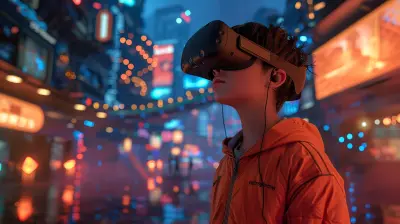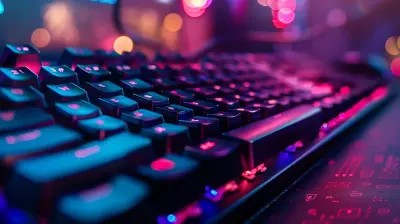Hand Tracking in VR: The Next Step for Immersive Interaction
31 May 2025
Picture this: You slip on a VR headset, and instead of fumbling with a controller, you simply wave your hand to swipe a menu or pinch your fingers together to pick up a virtual item. Feels like something straight out of a sci-fi movie, doesn’t it? Well, welcome to the world of hand tracking in VR—the next big leap in immersive gaming and interaction.
Hand tracking isn’t just about ditching clunky controllers (although that’s a huge win). It’s about transforming the way we experience virtual worlds, making them feel as natural and intuitive as playing with your own hands in the real world. So, grab your metaphorical popcorn because we’re diving into how hand tracking works, why it’s such a game-changer, and what it means for the future of VR.![]()
What Exactly Is Hand Tracking in VR?
Let’s keep it simple. Hand tracking is a technology that lets a virtual reality system recognize and interpret your hand movements. In other words, your hands become the controller. No buttons, no joysticks—just you and your gestures.How does this magic happen? Well, it’s not magic (though it feels like it). Cameras and sensors on the VR headset track the position, shape, and movement of your hands in real-time. Using a little thing called computer vision and some complex algorithms (don’t worry, you don’t need to do the math), VR systems can recreate your hand movements in the virtual world.![]()
Why Is Hand Tracking a Big Deal?
Let’s be real for a second—controllers are great, but they have their quirks. Trying to press the right button or navigate a menu while immersed in a VR world can sometimes feel like playing Twister with your fingers. Hand tracking, on the other hand (pun intended), gets rid of that awkward middleman.Imagine sculpting pottery in VR using your natural hand movements, high-fiving a virtual character, or even doing the infamous Macarena (don’t act like you’ve never thought about it). Hand tracking doesn’t just enhance gameplay; it amplifies the immersion. Suddenly, virtual worlds stop feeling like a game and start feeling like an extension of reality.![]()
How Does Hand Tracking Work?
Alright, let’s geek out for a moment without going full science textbook. Hand tracking relies on two main components: hardware and software.1. The Hardware: Cameras and Sensors
Most modern VR headsets, like the Meta Quest 2, come equipped with fancy cameras that can track your hand movements. These cameras capture the exact position of your hands, fingers, and joints, creating a digital replica in the virtual world.If the headset doesn’t have built-in cameras, external sensors (like gloves with trackers) can also do the job. But let’s face it, the fewer gadgets strapped to your body, the better.
2. The Software: Algorithms and AI
Here’s where the magic (aka the really smart math) happens. The software processes the data from the cameras and translates it into actions in VR. For example, if you close your hand into a fist, the system knows you’re gripping something. If you wave, your avatar waves back. Advanced algorithms ensure your hand movements are accurately mirrored in the game—because let’s be honest, no one wants their virtual fingers flailing around like spaghetti.What Can You Actually Do with Hand Tracking?
So, you’re probably wondering, “Okay, but how does this make my virtual life cooler?” Let me break it down with some fun use cases:Gaming Without Controllers
First up, gaming. Ever tried casting a spell in a VR game with a controller? It’s fun, but nothing compares to literally throwing a fireball with your bare hands. Hand tracking makes that possible. You can punch, grab, toss, and interact naturally without relying on buttons.Virtual Workspaces
Hand tracking isn’t just changing the game for gamers (see what I did there?). It’s also making a splash in productivity applications. Imagine sitting at a virtual desk, typing on a virtual keyboard, or dragging items around a virtual whiteboard—all with your hands. Goodbye, boring Zoom meetings. Hello, futuristic holograms.Training and Simulation
From surgeons practicing delicate procedures to pilots learning complex maneuvers, hand tracking is a game-changer for training. When precision is everything, being able to use your actual hands makes all the difference.Social Experiences
High-fives, handshakes, fist bumps—these are small gestures, but they’re huge when it comes to connection. Hand tracking makes social VR platforms feel less like a cartoon chatroom and more like a natural hangout spot.Challenges of Hand Tracking (Yep, It’s Not All Rainbows)
As amazing as it sounds, hand tracking isn’t without its challenges. Let’s address the glitch in the Matrix.1. Lighting Conditions
Hand tracking tech relies heavily on cameras, which means poor lighting can mess things up. Your VR headset might struggle to detect your hands in a dim room or if there’s glare. Ain’t nobody got time for that.2. Complex Gestures
While basic movements like grabbing or pointing work well, more intricate gestures can sometimes confuse the system. For example, trying to fold origami in VR might result in your virtual hands looking like they’re spasming. (Trust me, it’s hilarious but frustrating.)3. Device Limitations
Not all VR systems are created equal. Some headsets have more advanced tracking capabilities, while others are still catching up. If your headset can’t handle precision, the experience might feel less “wow” and more “meh.”The Future of Hand Tracking in VR
Alright, now let’s get starry-eyed about the future. Hand tracking is still in its early stages, but the possibilities are endless:- Haptic Feedback: Imagine feeling the texture of virtual objects with your hands. That’s where haptic gloves or advanced feedback systems come in. It’s like giving your hands virtual superpowers.
- Full-Body Interaction: Why stop at hands? Developers are already exploring full-body tracking, allowing for natural movement of legs, feet, and even facial expressions in VR.
- AI-Powered Gestures: Smarter algorithms will allow for more complex and intuitive hand gestures, making interactions feel even more lifelike.
The bottom line? We’re inching closer to VR that feels indistinguishable from reality. If you think hand tracking is cool now, just wait a couple of years.
Should You Jump on the Hand Tracking Bandwagon?
So, is this the future of VR, or just a fancy gimmick? Honestly, it’s both. Right now, hand tracking is like the early days of touchscreen smartphones—exciting, with plenty of room to grow. While it may not replace controllers entirely just yet, it’s laying the foundation for a more immersive VR experience.If you already own a hand-tracking-capable headset, give it a try. Gesture-based gaming and interactions are not only fun but incredibly satisfying. And if you don’t, keep an eye out—it’s only a matter of time before this tech becomes the new standard.
Final Thoughts: Hands Down, It’s a Game-Changer
Hand tracking in VR is the stuff of futuristic dreams, and it’s here to stay. Whether you’re hurling virtual fireballs, closing deals in a virtual office, or just vibing with friends in a hangout room, the possibilities are as vast as your imagination. Sure, there are a few hiccups along the way, but let’s admit it—innovation is messy. And honestly? We wouldn’t have it any other way.So, the next time you put on your VR headset, take a moment to appreciate how far we’ve come. Because in a world where your hands can control a universe, the future doesn’t just feel immersive—it feels limitless.
all images in this post were generated using AI tools
Category:
Virtual RealityAuthor:

Whitman Adams
Discussion
rate this article
3 comments
Sylas Edwards
Hand tracking in VR is a game-changer for immersion. It enhances interaction and realism, making virtual experiences feel more natural and engaging than ever.
June 18, 2025 at 4:56 AM

Whitman Adams
Thank you! I completely agree—hand tracking truly elevates the immersive experience, allowing for more intuitive and engaging interactions in virtual environments.
Jacqueline Romero
Hand tracking in VR? Finally, I can wave goodbye to the days of awkwardly flailing my arms like a windmill! I can’t wait to finally reach for that virtual sandwich without knocking over my real-life coffee. Just remember, virtual messes don’t clean up themselves!
June 6, 2025 at 4:51 AM

Whitman Adams
Glad you're excited! Hand tracking truly enhances immersion—no more windmill moments! And yes, a virtual mess still needs a real-life cleanup crew!
Zeal Montgomery
Finally, a way to wave goodbye to controllers—let's hope our hands don't betray us in VR!
June 4, 2025 at 4:15 AM

Whitman Adams
Absolutely! Hand tracking has the potential to revolutionize interaction in VR—let's embrace this new frontier!



